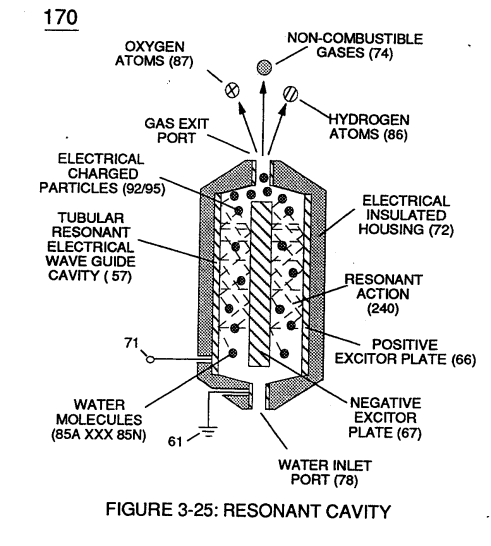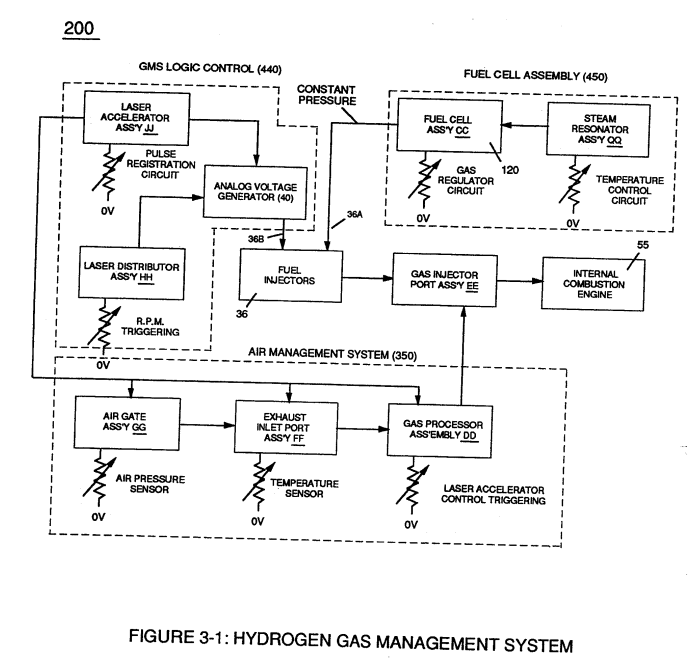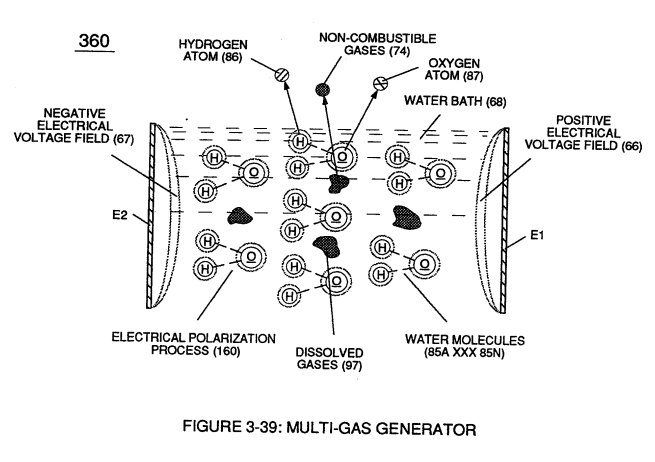| Figure (3-30) [](https://stanslegacy.com/uploads/images/gallery/2023-12/kRDULfVghXgQ3Mcm-image-1703377782828.png) | Figure (3-25) [](https://stanslegacy.com/uploads/images/gallery/2023-12/jmc1Z2WkjHNbWiZ6-image-1703201429384.png) |
Applied **electrical attraction force** (TT') and (UU') always being of **equal voltage intensity** but **opposite in electrical polarity** as **voltage amplitude** (65) is attenuated.
Replication of **higher voltage forces** (TT') and (UU') during pulsing operations causes a continued release of other **electrons** (92a xxx 92n) from other **water bath atoms** (93a xxx 93n) which, in practice, increases electrical charges of **water bath** (91) since **water bath** (91) is a dielectric liquid.
**[](https://stanslegacy.com/uploads/images/gallery/2023-12/jmc1Z2WkjHNbWiZ6-image-1703201429384.png)Water bath atoms** (93a xxx 93n) having missing **electrons** (92) take-on a **positive electrical charge** (95) which is subject to and moved by **negative electrical force** (UU'); whereby, the liberated and free floating **negative charge electrons** (92) are subject to and moved by **positive electrical force** (TT'). Applied together, **electrical forces** (TT') and (UU'), now, causes these moving electrically charged particles to superimpose a **physical impact** unto **electrical polarization process** (160), as shown in (170) of Figure (3-25)... thereby, increasing **gas-yield** (88) still further.
[](https://stanslegacy.com/uploads/images/gallery/2023-12/7ffVlnHJcIOSoYRS-image-1703232587555.png)By attenuating **voltage amplitude** (Vo xxx Yn) in conjunction with **pulse-width** (65a xxx 65n) allows **voltage intensifier circuit** (190) of Figure (3-23) to tune-in and match the resonant characteristics or resonant frequency of **water bath** (91) since **water bath** (91) always maintains its dielectric properties during pulsing operations.At resonance, **electrical polarization process** (160) interacts uniformly with liberated **charged particles** (92/95) of Figure (3-25) to obtain a even **higher gas-yield** (88) at **maximum voltage deflection** (xxx Vn).
[](https://stanslegacy.com/uploads/images/gallery/2023-12/jmc1Z2WkjHNbWiZ6-image-1703201429384.png)The **established resonant frequency** is most generally in the audio range from 1 kHz up to and beyond 10 kHz; and is dependent upon the amount of contaminants in **natural water**. Oscillating and superimposing **electrically charged particles** unto the **Electrical Polarization process** at a given pulse-frequency is, now, herein called "**Resonant Action**", as illustrated in (240) of Figure (3-25). To reach **maximum** **gas-yield** (88) **resonant cavity** (170) of Figure (3-25) is shaped into a **tubular structure** (typically 0.50 inch diameter tube inserted into 0.75 inch diameter tube having a .0625 concentric air-gap 3 inches long) which functions as a longitudinal wave-guide to enhance particle movement in a lateral or angular displacement to applied voltage fields (66/67). **Insulated housing** (72) prevents **voltage coupling to water bath** (68) which allows **applied voltage amplitude** (xxx Vn) to remain constant across **water molecules** (85a xxx 85n)... stabilizing gas production during voltage stimulation (65), as shown in (120) of Figure (3-24).
[](https://stanslegacy.com/uploads/images/gallery/2023-12/eS2UmsVf6o8YkE39-image-1703377231066.png)To further prevent voltage fluctuation during resonant action, **Phase Lock Loop** technique of **Pulse Indicator circuit** (110) is utilized during pulsing operations.
The resultant **fuel-gas** (88) is, now, transferred through **Quenching Tube** (96) of Figure (3-41) to, through and beyond **Fuel Injectors** (36) of Figure (3-1) for Hydrogen gas utilization. [](https://stanslegacy.com/uploads/images/gallery/2023-12/oLcI6QctvGXUJUGz-image-1703378297056.png)In cases where applied voltage amplitude is to remain constant while promoting **Resonant Action** during control-state, **incoming pulse train** (64a xxx 64n) is varied independent of voltage amplitude to attenuate **voltage intensity** (66/67) which, in turn, effects gas production.In other applications, **Voltage amplitude** (66/67) in direct relationship to **pulse-train** (64a xxx 64n) may be varied together in a progressive manner to further control gas production. Or pulse-train (64a xxx 64n) can remain constant while voltage amplitude is varied.
In all cases, **Resonant Action** is being promoted to produce hydrogen gas on demand.
In terms of Longevity, **voltage zones** (E1/E2) are composed of or made of stainless steel T304 material which is chemically inert to hydrogen, oxygen, and ambient air gases (*dissolved gases in water*) being liberated from **water bath** (68) during **voltage stimulation** (65). > Under actual certified laboratory testing stainless steel T304 life expectancy (*material decomposition*) is .0001 per year since **voltage** (65) is a physical force, setting up a non-chemical environment since amps consumption is being restricted to a minimum and "no" electrolyte is added to **water bath** (68).In practice, **stainless steel voltage plates** (E1/E2) physically forms **voltage zones** (66/67) regardless of geometric shape or configuration of **resonant cavity** (170).
Under normal gas ignition or gas combustion process, released **Fuel-Gases** (88) of Figure (3-39) as to Figure (3-24) nets a **thermal explosive energy yield** (gtnt) of approximately 2 1/2 rimes greater than gasoline.| Figure (3-39) [](https://stanslegacy.com/uploads/images/gallery/2023-12/DapPTPnafhxr0u3b-image-1703378524117.png) | Figure (3-24) [](https://stanslegacy.com/uploads/images/gallery/2023-12/eS2UmsVf6o8YkE39-image-1703377231066.png) |